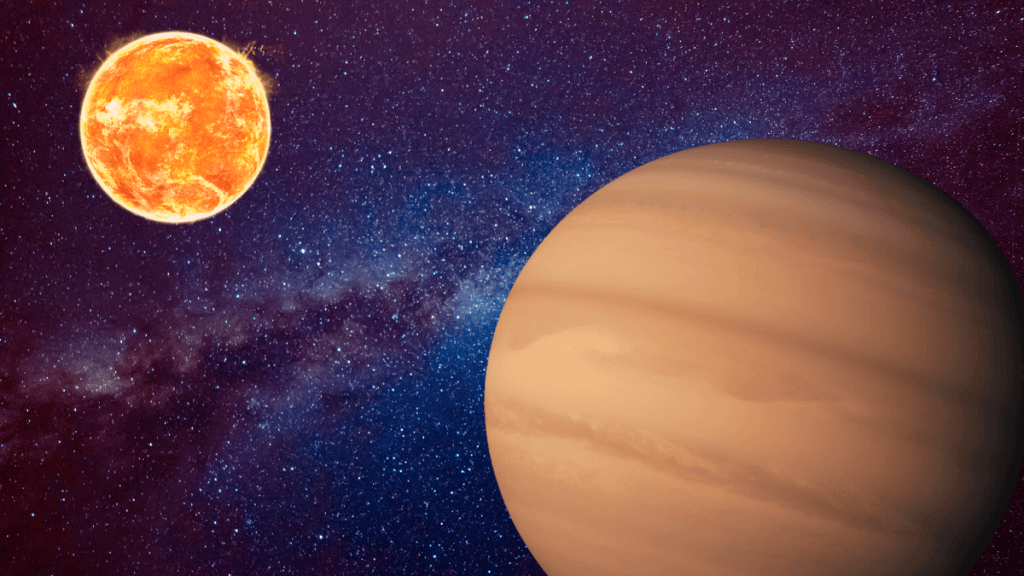A massive, Jupiter-size planet has been found orbiting a relatively small, low-mass star, surprising astronomers and challenging theories on how planets form.
The extrasolar planet, or exoplanet, orbits the red dwarf TOI-4860. Located in the constellation of Corvus, TOI-4860 has a mass equivalent to just around a third of the sun’s. The exoplanet in question, aptly designated TOI-4860 b , falls close enough to the star to complete an orbit approximately once every 1.5 Earth days, classifying it as a “warm Jupiter.”
This is unusual for two reasons.
First, with widths equivalent to about three-quarters of Jupiter’s, planets like this one aren’t supposed to form around low-mass stars. Second, TOI-4860 b seems to be enriched with a high proportion of metals — a term astronomers use to describe elements heavier than hydrogen and helium.
“Under the canonical planet formation model, the less mass a star has, the less massive is the disk of material around that star,” team member and University of Birmingham Ph.D. candidate, George Dransfield, said in a statement. “Since planets are created from that disk, high-mass planets like Jupiter were widely expected not to form. However, we were curious about this and wanted to check planetary candidates to see if it was possible. TOI-4860 is our first confirmation and also the lowest mass star hosting such a high mass planet.”
Related: Stars with superpowered magnetic fields could narrow the search for alien life
TOI-4860 b was first spotted by NASA’s Transiting Exoplanet Survey Satellite (TESS), which hunts planets outside the solar system by looking for tiny drops in the brightness of light emitted by stars. Those drops are caused as an orbiting planet crosses or transits its parent star’s face.
Dransfield and colleagues then followed this sighting up by observing the system with the Search for habitable Planets Eclipsing Ultra-cool Stars (SPECULOOS) South Observatory. SPECULOOS hunts for exoplanets with the same technique as TESS, but focuses on small and cool stars. As such, the facility based at the Paranal Observatory in Chile’s Atacama desert usually hunts Earth-size worlds, not considerably larger gas giants like TOI-4860 b.
Using SPECULOOS, the team saw the planet as it appeared and disappeared behind its star, with this observation followed up on alongside collaborators using the Subaru Telescope in Hawaii.
How such a large exoplanet came to orbit a low-mass star is something of a mystery, but the composition of TOI-4860 b could hint at its origins.
“A hint of what might have happened is hidden in the planetary properties, which appear particularly enriched in heavy elements,” University of Birmingham professor and team leader, Amaury Triaud, said. “We have detected something similar in the host star too.”
Triaud added that this abundance of heavy elements likely acted as a catalyst to boost the planet’s formation process.
The short orbital period of TOI-4860 b, in combination with the properties of its parent star, such as its high metalicity, means this system could be particularly useful for studying the atmospheres of warm Jupiters and better determining how these gas giants are born.
The team behind the discovery of this exoplanet now intends to hunt for similar worlds around diminutive parent stars using the Very Large Telescope (VLT), located in the Atacama desert region of northern Chile.
“I am ever thankful to the bright Ph.D. students of our team for proposing to observe systems like TOI-4860,” Triaud concluded. “Their work has really paid off since planets like TOI-4860 b are vital to deepening our understanding of planet formation.”
The discovery of the new exoplanet was documented in a paper published Aug. 4 in the journal Monthly Notices of the Royal Astronomical Society: Letters.

